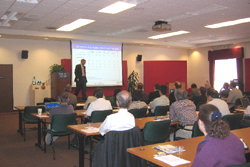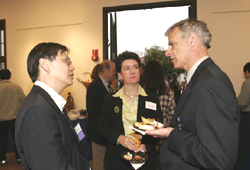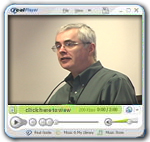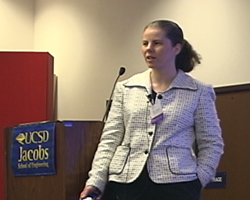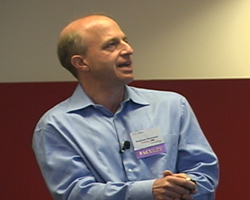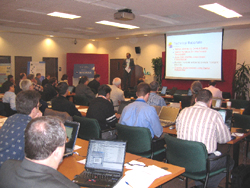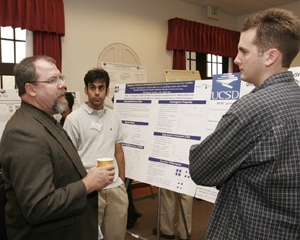UCSD, Calit2 Communications Faculty and Graduate Students Meet with Top Motorola Engineers
April 26, 2005 / By Doug Ramsey
4.26.05 -- Motorola has designated the University of California, San Diego as one of its preferred university research partners, and top engineers from the company underscored that distinction when they converged last week on the UCSD campus for their spring Scientific Advisory Board Associates (SABA) conference. "These meetings were a great kickoff for building a strong relationship with UCSD," said Charlie Backof, vice-chairman of SABA and Vice-President of Strategic Growth Engines in Motorola's Chief Technology Office. "There has been some engagement in the past, but we plan to build a much higher level of interaction."
|
Roughly 70 Motorola engineers -- representing the top 1-2% of the company's researchers -- participated in four days of meetings, including briefings by key UCSD faculty members and dozens of graduate students on their research in communications, materials and other fields. The Motorola meeting was co-hosted by the company and several UCSD research units, including the California Institute for Telecommunications and Information Technology (Calit2), Center for Wireless Communications (CWC), and the Jacobs School of Engineering's Corporate Affiliates Program (CAP).
Backof noted that Motorola sharpened its university partnership focus this year. "We reduced the number of our strategic universities worldwide, but plan to direct more interaction towards each of the remaining ones," he said. While some schools were dropped, Motorola added both UCSD and Carnegie Mellon to the elite roster. Currently, 15 university engineering schools are considered university technical partners, and nine business schools.
|
The four-day conference concluded last night with a dinner and talk by Calit2 director Larry Smarr. "I wanted to trace our research agenda from the optical core of the 21st century network, through to our work on nano, MEMS and chips," said Smarr, a professor of computer science and engineering in the Jacobs School. "I also wanted to emphasize what the new buildings in San Diego and Irvine will let us do, and the success Calit2 is having in forming interdisciplinary teams -- in collaboration with industry -- that get major government funding at both the state and federal levels."
Motorola executives made it clear that they want to work closely with the next generation of engineers at UCSD, and they were able to interact with more than 50 graduate students who showcased their work at a poster session. "I have always been impressed with the caliber of students we've recruited from the Jacobs School," said Paul Moroney, Vice-President of Advanced Technology in Motorola's San Diego-based Broadband Communications Sector unit. "We want to step up our active recruiting at UCSD, but we also want a long-term relationship that could include sponsored research projects, joint research, consulting with faculty, and other interactions."
|
The overall theme of the SABA meeting was "seamless mobility." Tom MacTavish, Vice-President of the Center for Human Interaction Research at Motorola Labs, explained how the company's four businesses -- personal devices, networks, government and enterprise, and the 'connected home' -- reflect its vision of anywhere, anytime connectivity. "We're living in an age of digitization of practically everything," he said. "There is rapid movement of data and you can receive intelligence everywhere, and high-speed wireless communication is becoming a standard for most of us." MacTavish noted that Motorola is well positioned to lead in two critical paradigm shifts. The cell phone, he explained, represents the 'fourth screen' (after the TV, PC and automotive displays), and the wireless Web is the 'fourth medium' (after precursor generations of newspapers, television and the Internet).
Calit2's division director at UCSD, Ramesh Rao, gave 'Motorolans' a primer on the UCSD research environment and described the many ways in which Calit2 interacts with its industry partners. The Motorola team also heard from Jacobs School dean Frieder Seible; Center for Networked Systems director Andrew Chien; and Pamela Cosman, co-director of CWC, whose talk stressed the breadth of the center's wireless research and the CWC value proposition. "A member company gains equal access to $2.5 million a year of wireless research being conducted by over 20 professors and 50 Ph.D. students," she said, "for annual dues of only $120,000."
|
Cosman also outlined some of the 10-year-old center's hottest new research areas, including cognitive radios, coding for wireless networks, and scalable video. Cosman's expertise is in multimedia coding and decoding, and she says that the varying demands of users -- based on the device and network they are using -- makes it an expensive proposition to offer many different versions of the same MPEG-4 video, since a different encoder is needed for each version. "With a scalable video coder, we can produce a single bit stream, and a very fast pre-decoder can peel off the correct segments of that stream to meet the different size and bandwidth demands of various users," Cosman told attendees. "We also believe that this comes with only a 10% penalty in the overall bit rate of that stream - in exchange for a whole slew of different spatial resolutions and qualities embedded in the stream."
One highlight of the conference was a panel discussion about "optimum utilization of radio spectrum." Three Motorola research executives -- Steve Bunch, Gary Grube and Joe Schuler -- shared the panel with three UCSD faculty: CWC director Larry Larson; Jacobs School electrical and computer engineering professor Rene Cruz; and Michael Kleeman, Director of Policy Research for Cyber Infrastructure in the graduate School of International Relations and Pacific Studies.
Before SABA's internal meetings began, half a dozen UCSD faculty briefed the Motorola engineers on their recent research. Calit2-affiliated Professor of Chemistry and Biochemistry Andrew Kummel explained his own work in chemical sensors as part of a wider review of UCSD research on electronic devices and materials.
|
Kummel also introduced Jacobs School electrical and computer engineering professor Yu-Hwa Lo as "one of the fathers of wafer bonding," and Lo went on to describe his work on bio-sensing systems on chip. "We are integrating all the fluidic, photonic, electronic, and acoustic components with different technologies to create a new technology platform and reduce the whole biological system at the chip level," said Lo. "It is bigger and considerably more complex than the typical electronic chip."
Both Lo and Kummel noted that UCSD researchers will be even better equipped to design and fabricate new materials and devices -- even at nano scale -- in the new clean rooms of Calit2's building at UCSD, now nearing completion.
Three other Electrical and Computer Engineering professors affiliated with CWC and Calit2 delivered presentations to the Motorola meeting. A recent faculty recruit, Gabriel Rebeiz, underscored the growing importance of UCSD in communications research in his talk about MEMS for reconfigurable wireless communications." "Eight of the members of my lab at the University of Michigan are now relocating to San Diego, and they will all be here by next September, and four more are joining the lab from inside UCSD," said Rebeiz, author of a best-selling book about radio frequency (RF) micro-electro-mechanical systems, RF MEMS [Wiley, 2003]. "It's a technology with no equivalent. These devices are becoming very reliable: lately we have been taking them to 380 billion cycles, and for a cell phone you only need them to last a few billion cycles." The newest RF MEMS are also much faster, he said, and hold the key to cramming more functionality into cell phones while making handsets smaller, lighter and more energy-efficient.
Motorola executives expressed interest in wireless automotive research, and professor Mohan Trivedi showed how he is pairing wireless and computer-vision technologies to make automobile driving safer. He described several projects underway in his Laboratory for Intelligent and Safe Automobiles (LISA), and gave more than 25 people from Motorola a tour of his automotive and computer-vision labs. "They saw live demos in all three car test-beds based on Nissan, VW and Mercedes models," said Trivedi. "We also showed them demos of lane tracking, surround capture, a real-time person tracker, gesture analysis, and traffic/bridge monitoring systems." Trivedi leads Calit2's Intelligent Transportation and Telematics research initiatives at UCSD.
|
ECE professor Bhaskar Rao is the lead PI on a substantial research effort in MIMO (multiple-input, multiple-output) technologies supported by the CWC member companies, and is also involved with MIMO-related projects supported by other private companies and the Army Research Office. "Using multiple antennas, we can exploit the spatial dimension to improve both the quality and the capacity of wireless networks," said Rao. "Our goals read like a wish list for communications engineers. Space-time processing can permit many more users on a network, improve the reliability and quality of the link, increase the footprint and coverage area of a base station, and require much less power consumption -- resulting in longer battery life."
The Jacobs School's Computer Science and Engineering department was represented by professor Bill Griswold. "Our newest investigation centers on the promise of cell phones as a computing platform," said Griswold, who dubbed his talk about the ActiveCampus project "explorations in ultra-ubiquitous computing."
Underscoring the interdisciplinary nature of research under the Calit2 umbrella, School of Medicine professor Leslie Lenert talked about the WIISARD (Wireless Internet Information System for Medical Response in Disasters) program he leads. Lenert and a team of electrical engineers led by Calit2's Ramesh Rao are improving communications technologies for first responders and other emergency medical personnel
|
after a disaster. "Wireless bridging and location-aware systems provide a backbone for all of these activities," noted Lenert. "We have come to believe that mesh networks are an important part of the solution, so we were intrigued to see that Motorola recently purchased a company in that arena."
Motorola's MacTavish described the company's strategy in seamless mobility as 'mobile me.' "It's all about mobility and the individual," he explained. "People don't live in zones or categories or segments. They move around literally and figuratively. The future of communications is in understanding the user's viewpoint and delivering user-centric content that is device- and context-sensitive, driven by affordable, available broadband." Other MacTavish predictions: applications will explode, with the digitization of everything at the edge of the network; privacy, security and safety will be critical for content that is purchased and created; and full mobility will assure the user of seamless 'always on, always here' connectivity, even across heterogeneous networks and devices.
Related Links
UCSD Motorola SABA Meeting
Center for Wireless Communications
WIISARD
Motorola
Media Contacts Media Contact: Doug Ramsey, (858) 822-5825, dramsey@ucsd.edu


